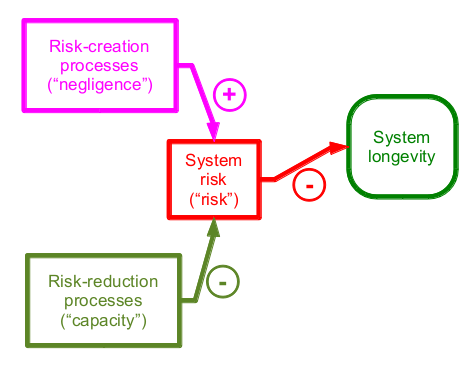Current projects at chira·net
A brief introduction of the following two models will help provide some context for the current activities at chira·net:
The Risk-Capacity Model
The basic idea of the Risk-Capability Model is that system longevity depends upon minimizing risks to system longevity, most importantly by increasing the capacity to reduce system risks:
Currently, the most relevant system to preserve right now is our ability to live and operate in such a way that gives us slack resources that we can worry about long-term survival. Various catastrophes that could end this happy state of affairs include nuclear war, environmental or social collapse, or dystopia. Unhappily, we lack good models to estimate the current system risk. Knowing the system risk might affect our own personal day-to-day decisions. For example, if the system risk is 3%, that means there is a 1-in-4 chance of the "world" ending before the next 10 years.
What does the Risk-Capacity Model mean for us as a society? It means that we need better risk-reduction processes. See "GRAM" below for a proposed project.
But first, let's visit what this model means for us personally.
The Individual-Capacity Model
The first part of this model links the "capacity" element of the Risk-Capacity model above. It states that society's capacity to reduce risks can be modified by individuals (for example, by making changes to institutions or to available knowledge). To determine the amount of societal improvement, sum, for all individuals, the "output" of each individual for a particular time period.

The second part of this model concerns the factors that support an individual's output (in this model, "output" means only: improving society's risk-reducing capacity). In each period, an individual decides how to allocate their time. The main categories of time use are output, improving effectiveness, self-support, and other activities.

The two main concerns presented by this model are:
- increasing the amount of time for "output" by changing priorities, simplifying one's lifestyle, or improving support.
- improving the effectiveness of the output, through education, skill-building, health, and improving social or economic circumstances.
To determine output for a period, "time" and "effectiveness" are multiplied together. An effectiveness near zero (or below) means that any time here is wasted. For example, individuals with insufficient learning may either be ineffective (such as a lawyer who donates to charities that do not ultimately reduce system risk) or harmful (donating to ideological causes that hurt society, or actively participating in terrorism).
Applying these models today
Given these models, what can we do today to reduce risk? Chira·net proposes to develop two sets of tools that any member of the public can use. The first tool, a GRAM website, helps people understand the current state of our society's capacity (as in the Risk-Capacity Model). The second tool helps an individual develop their own output (as in the Individual-Capacity Model) through self-education and online facilitation of the development of personal assets:
- Global risk and asset management (GRAM) — a website that provides a dashboard view of our world's current assets and risks for continued life, as well as efforts (by governments or others) to assess or manage these assets and risks.
- Personal risk and asset management — like the GRAM website, this will provide a dashboard view of current assets and risks, although in this case they are your own assets and risks. As well as tracking the assets that support maximizing the output of your own life (such as good physical, mental, and social health), it will also help you build assets through online tools to support lifestyle changes and staged training programs to integrate learning with everyday life. The curriculum will include topics enabling a person to understand global risk and asset management and societal change.
